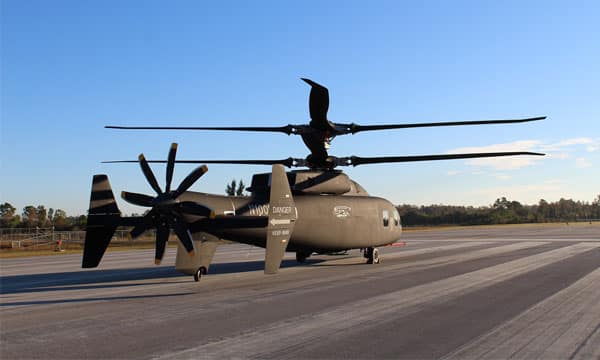On the occasion of the 5th helicopter exhibition, held on October 10 in Taijin, People's China, the state group AVIC presented a new helicopter model having the appearance of a flying saucer, the Super Great White Shark, or Super Great White Shark. Beyond its surprising appearance, to say the least, the performance expected for the prototype, whose first flight is expected for 2020, leaves the observer even more perplexed: top speed of 650 km/h, practical ceiling at 6000 m, rate climbed almost 3000 feet per minute, and to top it all off, reduced radar visibility. We can, obviously, suspect communication aimed at misleading Westerners, but it is true that the latest Chinese announcements considered not very credible in the West, such as anti-ship capabilities DF-21D and DF-26 missiles, call for greater caution.
7,60 m long and 2,85 m high, the Super Great White Shark is presented as a model of armed helicopter intended for combat operations, like the Chinese Z-10 and the AH-64 American Apache. The two-man crew is placed in the center of the aircraft, which is supported by two counter-rotating rotors 4,9 m in diameter, surrounding the cabin and fairing, giving the aircraft this flying saucer appearance. Horizontal propulsion would be provided by two turbojets integrated into the structure. Finally, the whole thing is covered with a coating that absorbs radar waves, so as to increase the stealth of the helicopter.

The fact is, this type of design is, in fact, not new at all. Like the “nuclear” propulsion used by the new Russian Burevestnik cruise missile, and experimented then abandoned by the United States in the 60s, and in particular by Avrocar, a prototype designed in the late 50s by Avro Canada, which never managed to achieve the expected specifications, and which was quickly abandoned by the US Air Force. But it is true that with the arrival of new materials and new technologies, concepts which had previously proved disappointing are now reaching maturity and giving rise to mass production, particularly in the field of helicopters. Thus, the principle of tilting rotors, of which the first prototype, the Bell XV-3, made its first flight in 1953, would not be used successfully until 1989, and the first flight of the V-22 Osprey. Likewise, the pusher propeller already equipped the Lockheed AH-64 Cheyenne in 1967, but we will have to wait until 2019 to see such a device equip another American aircraft, the SB1 Defiant from Sikorsky and Boeing.
In addition, work on "flying automobiles", very popular in recent years at innovation fairs, has made it possible to make significant progress in terms of ducted propellers and fans, while several models of turbojets small ones have also been developed, again with the market for flying cars and drones in their sights. Therefore, what was technologically inaccessible a few years ago can now be achievable.

That said, other factors can create doubt about the performance announced by AVIC. First of all, the shape of the device seems very incompatible with the announced performances, and in particular the speed, due to the immense drag that it will generate as the speed increases. In addition, aerodynamic control beyond low speeds is likely to be very difficult for such an aircraft, due to the aerodynamic turbulence and drag generated by this imposing mass. This drag, finally, will directly oppose the movement of the aircraft, requiring an additional expenditure of energy to cover an equivalent distance, which will significantly reduce the autonomy and range of action of the device.

It is more than likely that Chinese aircraft manufacturers, like their Western and Russian counterparts, are engaged in a race to improve the performance and survivability of rotary wings, including, among other things, increasing speed. As it is likely that one of the lines of research gave birth to the Super Great White Shark, to study its different parameters, opportunities and constraints. However, it seems difficult to imagine that such a design could, one day, result in a mass-produced combat aircraft. More advanced and less restrictive solutions seem to be emerging, such as propellers, tilting rotors, and why not, one day, mobile blowers. On the other hand, the Super Great White Shark is likely to remain a trade show and exhibition prototype, intended to capture the attention of visitors and the media.
